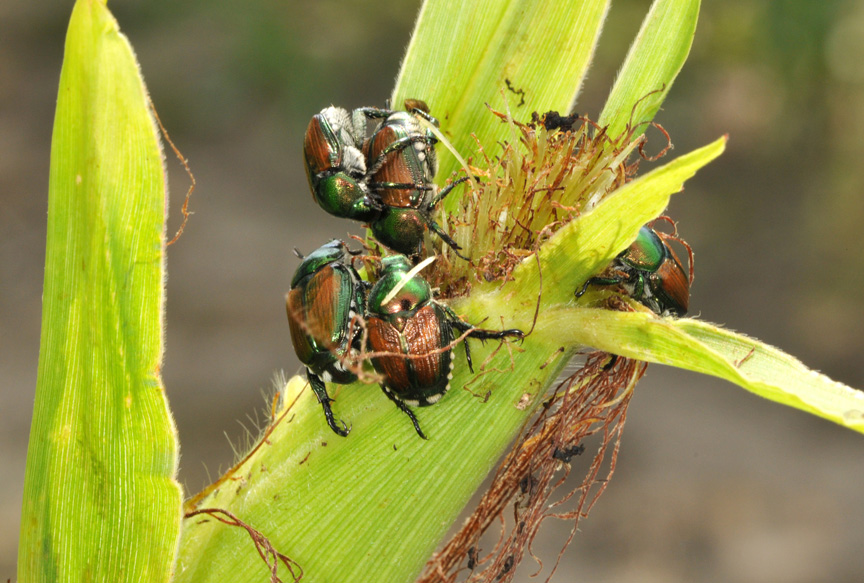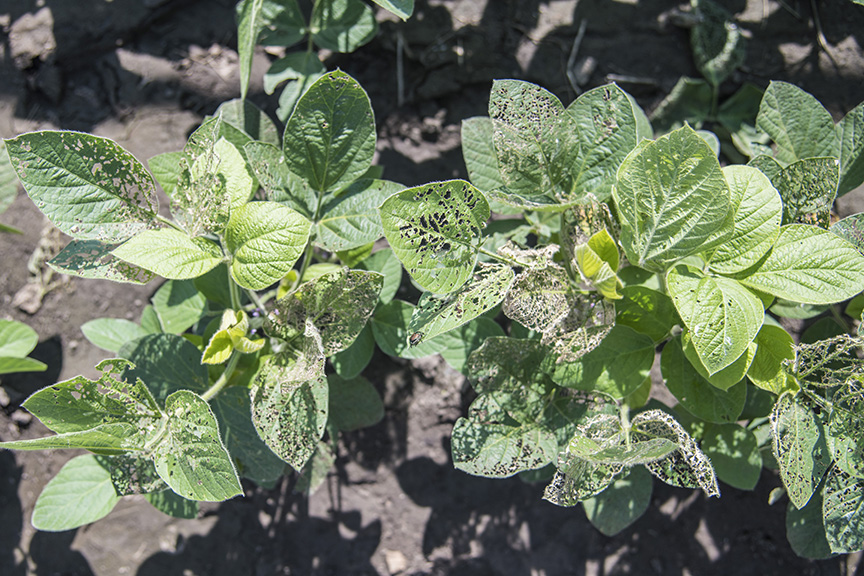News flash … Japanese beetle have been emerging and can be seen throughout the state on corn and soybean plants. OK, not that news worthy. How about … some areas of state are seeing tremendous numbers of beetles while some areas aren’t that excited. Again, old news, as this happens every year. Here is a headline sure to grab attention … Japanese beetle – their presence and damage is usually perceived worse than it is. Please refer to the following treatment thresholds.
Field Corn: Japanese beetle feed on corn leaves, tassels, and silks. Generally, leaf and tassel feeding can be ignored. If beetles are present and feeding on corn silks, an insecticide should be applied only if on average the silks are being cut off to less than 1/2 inch before 50% pollination has taken place. This rarely happens on a field-wide basis. Don’t be overly excited by this pest’s tendency to clump on a few ears within an area and eat the silks down to the husks. With sufficient soil moisture, silks will grow from 1/2 to 1 inch per day during the one to two weeks of pollen shed. Silks only need to be peeking out of the husk to receive pollen. Besides, beetles are often attracted to silks that have already completed the fertilization process even though they are still somewhat yellow. Check for pollen shed and silk feeding in several areas of the field, Japanese beetles tend to be present only in the outer rows of the field. Don’t be influenced by what you think you may see from windshield surveys! Get out into fields to determine beetle activity. Be sure to walk in beyond the border rows before drawing any conclusions.

Japanese beetle “parties” on selected ears may give false impressions of pollination problems for the whole field.
Soybean: Soybean plants have the amazing ability to withstand considerable leaf removal (defoliation) before yield is impacted. The impact of defoliation is greatest during pod fill because of the importance of leaf area to photosynthesis, and ultimately to yield. Therefore, approximately 15-25% defoliation from bloom to pod fill can be tolerated before yields are economically affected This defoliation must occur for the whole plant, not just the upper canopy. The beetles often congregate in areas of a field where they are first attracted to weeds such as smartweed. Typically, if economic damage occurs, it is only in these areas. Therefore, spot treatments should be considered. Don’t be overly alarmed by these bright, iridescent beetles that feed on the top canopy of the soybean plants. Consider that as they feed their defoliation allows for better sunlight penetration into the lower plant canopy!

Japanese beetle will move to new feeding locations, notice how the new growth of these plants have very little damage.
Kill the beetles to prevent grubs?: Japanese beetle develop from grubs that fed on organic matter and/or the roots of plants last fall and this spring. Therefore, it seems logical that killing adult beetles one year should prevent grub damage the next. At least some farmers have explained this to me to justify sub-economic damage in a field. However, it simply doesn’t work that way. Entomologists for decades have been trying to understand this fickle creature. Basically, the adults feed, mate, and lay eggs when and where they want to. The grubs are just as unpredictable. Research attempts to correlate grub presence to crop damage have been inconclusive. Damage does occur, but we are just not usually able to predict when or assess how much. Consider that each beetle mates and lays eggs several times during its oviposition period. To prevent egg laying in a field, one would need to treat multiple times during July and August, which is not economic or practical. If you are wondering, seed-applied insecticides, i.e., Poncho and Cruiser, provide some suppression of white grubs.


